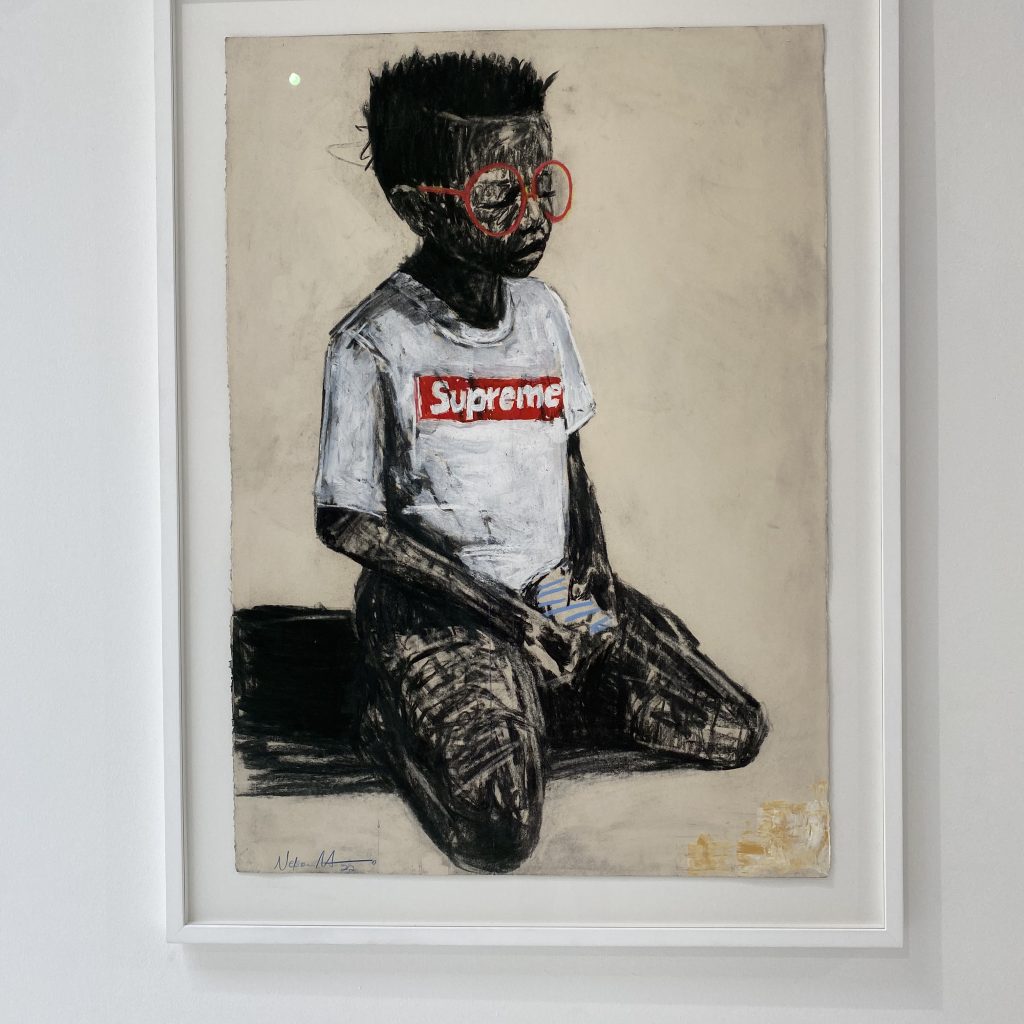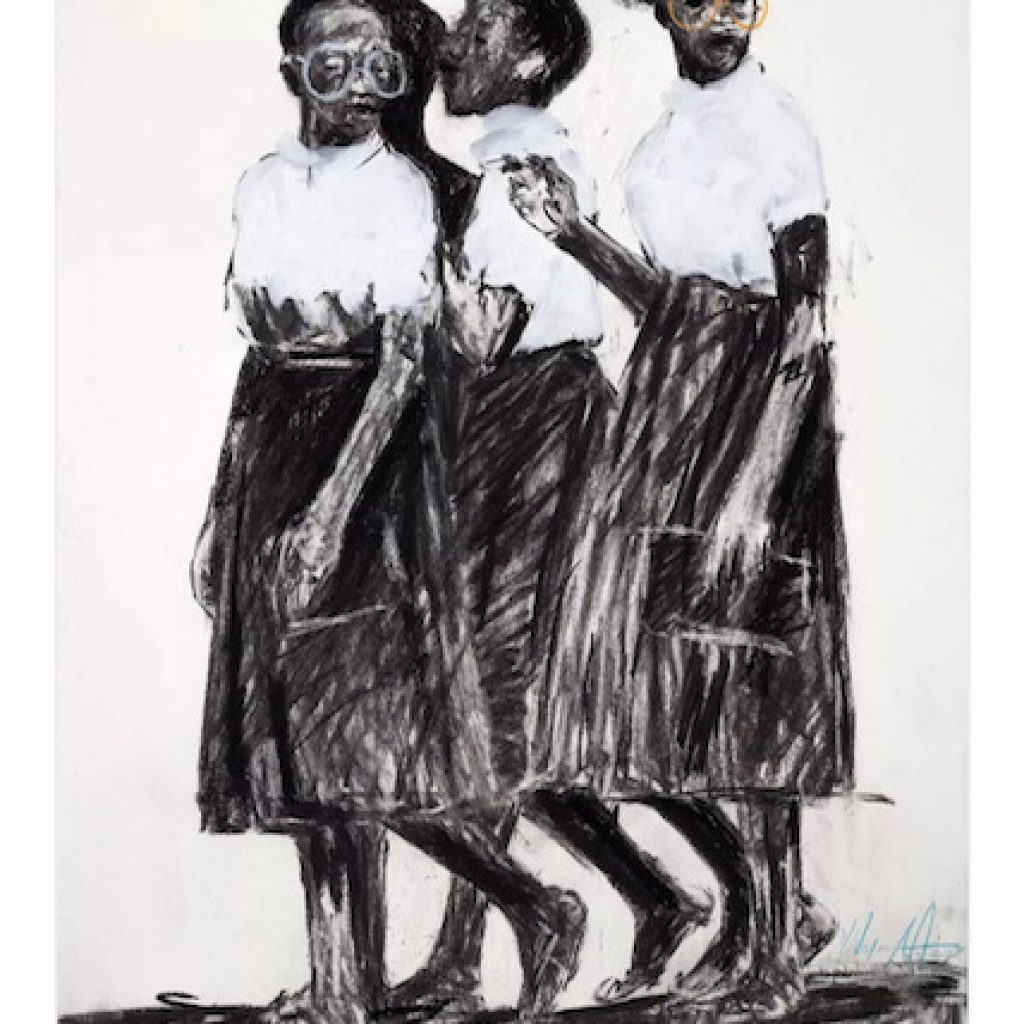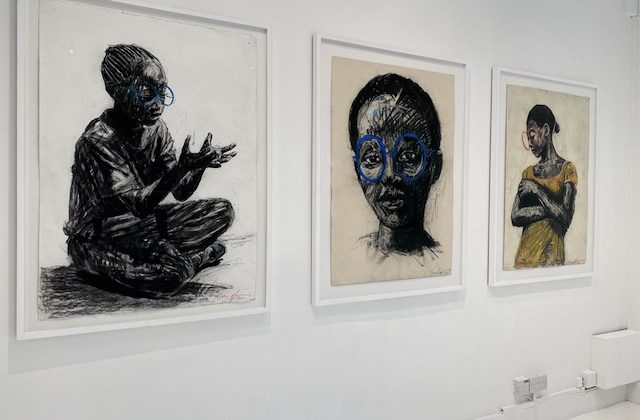Omusana Review is delighted to present an exclusive interview with Phin Jennings of Rise Art, an online gallery that champions contemporary artists. Rise Art works to expand representation and access through online exhibitions as well as physical programming. Currently, Rise Art is hosting a pop-up exhibition for the celebrated South African artist Nelson Makamo. Phin Jennings is the co-curator of the exhibition along with James Kahuri. As Phin tells us, “the show is a real survey of everything [Nelson] has been working on since he was last here…[in 2017].” The audience will see some of the drawings Makamo is celebrated for– the close-up portraits of African children wearing brightly colored glasses—their large eyes and innocence accentuated.
In addition, the audience is introduced to new portraits that focus on the theme of community. If the earlier catalogue focused on the individual, this new body of work zooms out to show us characters in their community going about daily life. We see them in groups; they are active–—picking flowers, going to school, and peeking over a wall. Yet, the exhibition stays true to the themes in Makamo’s earlier work: love, beauty, mischief, hope, and dignity. In this conversation, Phin gives us insight into how this exhibition came together. He highlights the collaborative partnership with Makamo and helps us understand the core values of Rise Art. Below is our conversation.
LKL: My name is Lydia Kakwera Levy. I am interviewing Phin Jennings, curator at Rise Art and co-curator of Nelson Makamo’s first Solo Exhibition in London in over five years.
PHIN: Hi, I’m Phin. We’re here at Nelson’s exhibition at Great Titchfield Street. We opened last night, and we were just discussing Nelson’s practice, where this show has come from, and where he’s taken this show. I was just saying to you his portrait works, especially the ones with glasses, that’s something Nelson is known for, and I think they are an important part of his practice, and in this show, he’s trying to break out of the box a little bit. We’re seeing a lot more works of people in their community; we’re seeing full bodies, seeing what they’re wearing and how they’re moving, who they’re with and what they’re looking at—that kind of thing. These are more holistic portraits. I think it’s important for an artist like Nelson because it’s easy—to start doing close-up portraits and then to be put in a box, to be pigeonholed as an artist– and in this show, he is doing more than that—his practice has breadth which is really exciting for me. At the same time—there is a thread that runs through it. There is this feeling of hope, and of vision, curiosity, and optimism visible through it.
LKL: If you go back to his previous show here in London, which took place in 2017-those portraits of children with glasses were so captivating and different from the typical portrait of African Children, that they set him apart immediately. What I took away from that show was the vitality, whimsical ingenuity, and curiosity of children. To me, the glasses symbolized an awareness to engage the future. How do you think his practice has changed since 2017? Now people know his name, Oprah knows his name–how does he relate to the fame and continue to work?
PHIN: What I’ve noticed in Nelson is that he’s keen to keep it real. Suddenly he has all of these people who want to talk to him, who want to engage with his work; he wants to talk to everyone. I think you said there are celebrity collectors, and all these people want to engage with his work. And it doesn’t matter who you are; if you’re engaging with his work and having a moment with his artwork, that means a lot to him. He prioritizes those people who he feels are connected with his work.

LKL: He’s very humble.
PHIN: He’s super humble. The people that I notice he is most excited to talk to are people that have experience of growing up in a village in South Africa or a village in Africa—sharing stories and sharing experiences, sharing memories with those people. That hasn’t changed since 2017 and even before 2017. That hasn’t change
LKL: As the co-curator for the show, can you talk about the process of approaching him? Could you give us a little bit of the behind-the-scenes?
PHIN: We at Rise Art—we had a prize in 2018. Nelson had one work in our show and won the drawing prize. Since then, he has been a friend of Rise Art. And we’d said ‘we want to show your work in London’ and it’s just been a case of waiting for the right time to do it. So we decided we were going to do it this year. We went to Johannesburg to visit his studio and choose the works—Nelson works in an interesting way, where he is working on a lot of things all at once. Nothing is finished, so he might pull something out from two years ago to work on it. So we went to his studio, surrounded with pieces of paper he had created since we last showed with him. We picked out the works and thought about a theme for the show; ultimately, we wanted this to be a re-introduction of Nelson to London. London is one of his favorite places to show; he hasn’t been here in so long that we wanted to be: “Hi, I’m back.” So the show is a real survey of everything he has been working on since he was last here. He completed all the works, signed them, and shipped them off to London. And here we are. Nelson loves to collaborate, and many artists do gallery shows and put everything in the hands of the gallery curators, and they choose the works. In this case, it was Nelson, myself, and James Kahuri—it was a collaborative process from start to finish. On everything, from choosing the works, the way they are installed, the events we’re doing, everything is a collaboration. Nelson, which I think is fantastic, likes to be involved in every step of the process. He wants to be part of it and engage with it.
LKL: In putting this show together, did you go into it with a particular theme, or were you inspired by just seeing Nelson’s catalogue and thinking about which pieces would fit together?
PHIN: None of us had an agenda but the theme that I had in mind—is that he was interested in drawing and painting groups of people. I thought that was really interesting in terms of how much you can learn about a person when you see who they are with, what they’re wearing, and see what they’re doing. The intimacy of the close-up portraits—doesn’t go away. I wanted to show works that give context, especially when the showing is outside of Africa—I wanted people to get the context of where these subjects are and who they are. The process was very collaborative, and it ended up—a mixture of works we couldn’t say no—it’s a survey of his work.
LKL: It goes hand in hand with the narrative he is trying to present; he wants to ensure that his views are coming through clearly. There is agency in all he does. Can you speak a little bit about Rise Art? What are the core values of Rise Art?
PHIN: The main thing Rise Art wants to do is support the careers of emerging, mid-career, and established artists. The main thing we do is sell artists’ work online. We have a roster of over 1000 hand-picked artists; we hand-pick the artists, invite them to join our website, and then place their works with public collections and private collections. I think the main goal is to get artists’ work seen, get artists paid, and give artists a credible place in the online space to show and sell their work. We give a credible space with international representation. In the last couple of years, the online presence has become so so important, and we try to help with that. Alongside, we do pop-up events—group shows and solo exhibitions to showcase artists and bring what they do to the physical world.
LKL: You said something that sparked my interest – how we’re getting back to this physical space [after the pandemic]; we have the online, but we still need spaces to physically showcase artists. In your view, how do the two go hand in hand?
PHIN: It’s a good question. It’s one we’re still trying to figure the answer to how the two go hand in hand. In 2020 a lot of the big galleries—who are primarily physical exhibitions– really built out their online presence. That was the same year –towards the end of 2020/2021—when we started doing physical shows. I don’t know who coined the term, but I’ve heard the term – Clicks and Mortar- a hybrid model where you have in-person physical programming and online. I think the two need to go hand in hand. For the artist, online is fantastic to get an international audience and to have that reach. But, physical is so important so you can see the work and also so you can encounter people, meet people and talk to people. If you hadn’t walked into the gallery, we wouldn’t be having this conversation. This show has been open for a few hours, but it’s been a great success, and it’s been amazing to meet so many people through doing it that wouldn’t have happened online. The most important thing about having a physical space is it allows us to have those interactions with people and meet face to face.
LKL: What drives your passion for curating African artists? Who are some artists you would recommend for people who don’t know about African Art or Global art in general? Who are the artists you feel like ‘please go, see, and learn about this person?’
PHIN: Wow
LKL: Yeah, that’s two questions in one—I’m sorry.
PHIN: The first, how do we get into curating African Art? African art is really popular in the UK right now. The market and curators could do more; maybe people need to realize that Africa is a continent, not a country. People showing African artists—could show Kenyan artists, Ghanaian artists, South African, and Ivory Coast—Africa is an incredibly diverse continent. Often, people put African Art in a box and tick that box, where we don’t talk about European art—we talk about Italian art, British artists, and French artists. I’m hoping in years to come, people will start seeing those differences. The UK market is more educated and loves African Art but also can identify artists from different countries and understand the differences and similarities between them. In terms of what to see at the moment, there are a lot of fantastic African galleries—Addis Fine Art, Tiwani Contemporary is doing a really great job, and we’re doing our bit. But the most important thing is to support African-owned galleries that are supporting African artists, and making sure the support [flows to] galleries on the continent. All Galleries should have African artists on their roster; they should support African artists and writers.
LKL: Well, I’m not going to take up any more of your time, but is there anything you would say to somebody unfamiliar with the artists you represent? Is there some recommendation you would make?
PHIN: On Rise Art- our Assistant Curator Verity updates our Weekly Picks collection every week. That is about thirty works every week on the radar that are hot. That is a fantastic place to start. Rise Art.com and/or following us on Instagram is the best way to see all the artists we represent and the breadth and diversity of what we do.
LKL: Thank you for this conversation, Phin. It was a rare opportunity to see Nelson, so congratulations for curating this exhibition.

Note: The exhibition, Rise Art Presents Nelson Makamo is still open and free. It will run until 25 August 2022. The gallery is located at 67 Great Titchfield Street, London W1W7PT. This interview took place on July 22, 2022.


